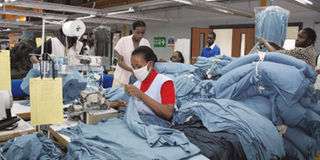Row brews over EPZ’s lobby for higher quota

PHOTO | FILE Seamstresses working for a clothing firm at at EPZ Athi river.
What you need to know:
- EPZA has written to the East African Community secretariat seeking to increase the maximum quantity of manufactured goods it sells in East Africa from the current 20 per cent to at least 70 per cent
- Prior to the adoption of the East African Community Customs Union in 2010, the 20 per cent rule applied to sales within a country’s boundaries, meaning that locally based investors in the EPZ could sell the bulk of their products in the region’s markets
- Over the last five years, the value of Kenya’s exports has been rising year on year with last year’s exports totalling to Sh511 billion, up from Sh409 billion in 2010
- Last year, exports to the EAC accounted for 27 per cent of Kenya’s total exports up from 25 per cent of the total value of exports in 2010
A row is brewing between local manufacturers and those protected under Export Processing Zones Authority (EPZA) who are lobbying East African governments to allow them to increase the quantity of products they sell in the regional market.
EPZA has written to the East African Community secretariat seeking to increase the maximum quantity of manufactured goods it sells in East Africa from the current 20 per cent to at least 70 per cent.
The proposal is already facing objections from the Kenya Association of Manufacturers (KAM) who argue that if passed, it would give undue advantage to investors under the EPZA at the expense of other manufacturers.
According to KAM, investors in the Export Processing Zones already enjoy tax benefits unlike other manufacturers, and increasing the volume of goods they sell locally would give them the opportunity to earn more while thriving on lower manufacturing costs.
“By allowing the proposal, we will be creating an uneven playing field for local manufacturers. Investors in the EPZ already enjoy a number of benefits so that they can manufacture for export purposes unlike other manufacturers,” said Jaswinder Bedi, chairman of KAM.
Prior to the adoption of the East African Community Customs Union in 2010, the 20 per cent rule applied to sales within a country’s boundaries, meaning that locally based investors in the EPZ could sell the bulk of their products in the region’s markets.
The customs protocol paved way for the creation of a common market between the five EAC member states which extended the meaning of a domestic market from a specific country’s territory to the EAC region market as a whole.
This means that EPZ investors are now restricted to selling only 20 per cent of their output within the region while the rest is destined for markets outside the EAC.
The move by the EPZ to seek an extension of the restricted quantity of products to be sold locally is therefore a step towards protecting investors in the EPZ who rely on regional markets as their main export destinations.
“EPZA is seeking to protect export processing companies that have thrived on the region’s markets to dispose their products. With the adoption of the Customs Union, those companies that relied on the region’s markets as their main markets are bound to suffer and could possibly come down if the proposals we have presented are not looked into,” EPZA chairman Mathenge Wanderi told the Sunday Nation.
There are about 88 companies operating in 44 export processing zones in Kenya. Two of these zones sit on public land in Athi River and Kipevu while the rest are located on private land.
Last year, exports from the EPZ totalled to Sh36 billion, up from the Sh32 billion realised the previous year.
Of the total production from the EPZ, Mr Wanderi says that 80 per cent is made up of textile products that are sold in Europe and other international markets.
The statistics could further fuel objections to the application for an extension of the maximum quantity of EPZ output that can be sold locally given that the majority of the companies in the EPZ do not rely on the EAC market to dispose their products.
Further, by allowing EPZ investors to sell more locally, manufacturers feel that the move will have diluted the purpose for which the EPZs were set up and encourage unfair competition.
“The proposal poses a number of challenges to the local manufacturers as it will expose them to unfair trade practices. As they enjoy tax benefits, EPZ companies will have the opportunity to lower their prices and this will definitely affect the sales of local companies operating outside the EPZ,” said Rakesh Rao, chief executive of Crown Berger Paints.
Over the last five years, the value of Kenya’s exports has been rising year on year with last year’s exports totalling to Sh511 billion, up from Sh409 billion in 2010.
Last year, exports to the EAC accounted for 27 per cent of Kenya’s total exports up from 25 per cent of the total value of exports in 2010.
The war between the manufacturer’s umbrella body and the EPZA comes at a time when the Cabinet has approved a bill seeking the creation of Special Economic Zones which both sides have welcomed, saying that they would spur industrialisation and growth of the manufacturing sector.
The Special Economic Zones policy and bill approved by Cabinet on November 8 under the chairmanship of President Kibaki will see special economic zones created in Lamu, Mombasa and Kisumu which have already been identified as pilot areas for the project.
SEZs, as they are popularly called, will entail the setting up of manufacturing companies within the zones that will enjoy tax exemptions when importing raw materials for the manufacture of products meant for exports.
But unlike manufacturing firms operating in the EPZs, the companies will be required to pay full duty as paid by foreign companies intending to sell products locally.




